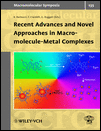Ultrafiltration of Polymer-Metal Complexes for Metal Ion Removal from Wastewaters
Abstract
Summary: A case-study using macromolecular metal complexes is described. The results of a process named Polymer Assisted Ultrafiltration (PAUF) for ion removal from various types of waters is reported. The water soluble polymers such as polyetilenimine (PEI), polyacrylic acid (PAA), polyacrylic acid sodium salt (PAASS) and poly(dimethylamine–co–epichlorohydrin–co–ethylenediamine) (PDEHED) as chelating agents, the Cu2+ as model ion and five ultrafiltration membranes have been used. The complexing agents were previously tested to establish the binding capacity and the best operating conditions for the process. Among the tested polymers the PEI appeared the most interesting one because its binding mechanism does not involve a counter ion release. It was tested in the simulation of wastewaters treatment containing the Cu2+ ion chelated with citric acid; this is a problem of interest in the recycling of water from soil washing operations. The polyethylenimine quantitatively bound the copper-citrate chelate at pH 5.5 and the three component complex was separated by UF membranes producing a permeate with very low metal concentration. The polymer regeneration was carried out with good results by operating with the diafiltration method. The copper ion present in the diafiltration permeate in a form chelated with citric acid was recovered by oxidising the citrate in a membrane photoreactor. The positive results of the described case-study show that Macromolecule-Metal Complexes play a key role for running effectively and selectively the PAUF process for removing metal ions from various type of waters.




